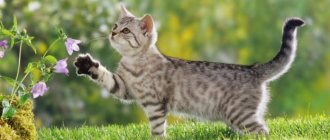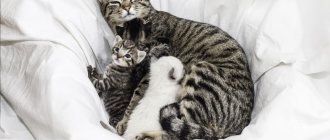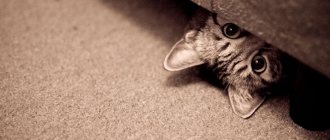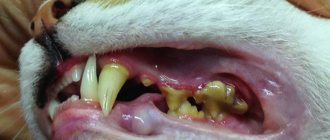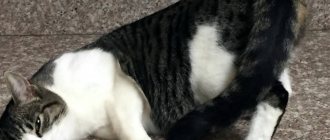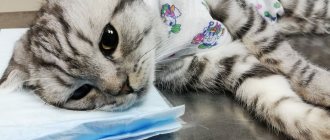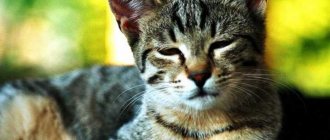Can a cat get pregnant during lactation?
Can a nursing cat get pregnant again?
Certainly! On average, a cat begins to go into heat 1.5-2 months after the birth of kittens. And some favorites are ready for mating even earlier: 1.5-2 weeks after lambing. Consequently, pregnancy can occur in a cat that has recently given birth to babies. By the way, some owners unknowingly claim that during the period of feeding kittens, their mother is not able to become pregnant again.
This opinion is based on the fact that the hormone prolactin, produced during pregnancy and lactation, prevents the conception of new offspring by blocking the hormones responsible for ovulation. This statement is true for breastfeeding women, but not for cats. The fact is that ovulation in pets occurs at the moment of mating, as soon as interest in carnal pleasures appears during the estrus that appears after lambing. Thus, the question of whether a cat can become pregnant while nursing kittens can be answered in the affirmative.
How soon after giving birth can a cat go into heat?
After a cat has given birth to kittens, many owners believe that she will not ask for a cat for a long time. In fact, in nature, cats are ready to give birth again literally 1-2 months after giving birth. It is after this period of time that they go into heat.
However, you shouldn’t be surprised if the cat went on a spree much earlier. Sometimes she may go into heat literally a week after giving birth. This is a rather serious malfunction in the body. Usually it is provoked by the owners themselves when they give the cat the wrong food. Excessively high-calorie and plentiful food, which is complemented by warmth, is a signal to the cat’s body that it can again bear offspring. Also, sometimes such disruptions in the body cause cat diseases.
Why is contact between a nursing cat and a cat harmful?
Let's say a cat owner has the opportunity to adopt kittens. So why is it worth stopping a cat’s attempts to mate with males while she is still feeding her babies? There are many reasons for this:
- Pregnancy, childbirth and feeding kittens is a difficult time for an animal. A lot of effort is expended, most of the vitamins and minerals obtained from food are spent on the growth of embryos, and hormonal changes occur in the mother cat. Too frequent births simply wear out the pet’s body. Often, cats that give birth frequently have problems with bones and reproductive organs. Animals that become pregnant again after giving birth to kittens usually cannot boast of longevity. Veterinarians believe that the optimal number of births for an adult healthy pet is once or maximum twice a year. Frequent pregnancies are a real stress for the reproductive system and the entire body of the animal;
In fact, the offspring abandoned by a mother cat who has gone on a spree have to be fed by the owner himself with a milk replacer from a pipette or syringe. And this is quite tedious, since it is difficult to feed a small kitten. Yes, and it’s costly financially. Even if the pet does not completely stop feeding its young, its lactation will still be reduced;
A nursing cat can become pregnant within a couple of weeks after giving birth, when the mucous membrane of her genital organs is still susceptible to infection;
- A nursing mother cat should eat well and gain strength after giving birth. But if the pet begins to go into heat, her appetite will be reduced or disappear altogether, which will negatively affect the condition of the body. As a result, both the adult animal, the recently born kittens, and the embryos from the next litter will suffer.
When the pet is no longer able to produce kittens
Having dealt with the question of how often cats give birth, it is necessary to determine the age at which mating should be stopped. The behavior and body characteristics of animals allow them to give birth throughout their lives.
A kitten can be born even from an old cat. Usually in this case the number of cubs is no more than 2. Despite the high fertility, it is not advisable to breed a pet that is more than 7 years old. When this age is reached, the animal is sterilized to avoid unnecessary problems.
Pregnancy is a difficult test for the body of an adult cat. Therefore, there is a risk of not only harming the pet’s health, but also producing weak offspring.
Every owner is interested in the question of how the pet’s pregnancy is going, how long it will take for her to have kittens again, and also how to choose the optimal period for breeding. Knowing the nature of cat health, owners will be able to create comfortable conditions for the animal’s life, and also prevent the appearance of unwanted offspring.
How to prevent pregnancy in a nursing cat
If the cat does not participate in breeding, and its offspring are not of particular financial interest to the owner, it is advisable to sterilize the animal. The best time for this is after 6 months - 1 year. Theoretically, it is possible to perform surgery on a nursing mother cat to prevent her from becoming pregnant again.
You should not use alcohol tincture or valerian tablets as a natural sedative. This remedy for pets is a drug that puts them in a state of extreme excitement. That is, a cat who has started to heat, after a small amount of valerian solution or tablets, will have one goal - to quickly connect with the cat. The existing kittens will naturally go to the side.
What to do if a nursing cat becomes pregnant
- Allow the cat to give birth to her next babies, and then bring her to the veterinary clinic for surgery to remove the ovaries or remove both the ovaries and the uterus;
Show the pregnant cat to a specialist and seek advice about surgical abortion (an incision will be made in the uterus through which the embryos will be removed). It is important to do this no later than 4-5 weeks of pregnancy;
Contact a veterinarian for abortion and sterilization of the pregnant pet (the babies will be removed along with the uterus and ovaries);
When asked by cat owners who observe atypical behavior in their pets, whether a nursing cat can become pregnant, the answer is yes. Prolactin is responsible for milk production, which should block the ovulation process. In fact, cats have no such rule and your furry beauty can become pregnant during the feeding period.
False and frozen pregnancy
False pregnancy, diagnosed extremely rarely, is considered a natural physiological process. Its symptoms (drowsiness, caution in movements, increased appetite, slight enlargement of the nipples) are usually erased and do not threaten the cat’s health.
The reason for consulting a veterinarian should be such hypertrophied signs as:
- noticeably enlarged belly;
- severely swollen nipples;
- secretion of milk;
- the cat sets up a “nest”, and also “gives birth” and nurses “babies”;
- the animal “gets pregnant” after one or two or after the next heat.
Only a specialist can distinguish an imaginary pregnancy from a real one (using ultrasound, palpation and x-rays). He also prescribes therapy that normalizes the level of sex hormones, or sterilization. Ultrasound examination also helps to identify frozen pregnancy, in which one or more embryos die due to infections, hormonal imbalance and fetal development abnormalities.
This is interesting!
If not all embryos are dead, the pregnancy is preserved: they are released during childbirth along with live kittens. If all embryos die, a miscarriage is expected or labor is stimulated with medication to avoid their decomposition.
After the cat has given birth, she is examined to ensure the cleanliness of the uterus. Often, after a missed pregnancy, the animal is sterilized.
Home birth is indicated for normal pregnancy: the cat does not experience stress from a change in environment, and the risk of contracting an infection is reduced to zero. The veterinarian is called only in special cases.
Induction of labor
They resort to it when gestation is prolonged. No amateur activities or folk methods, which often lead to long labor and injury to the cervix, for example, with self-administration of oxytocin. Only the doctor will decide whether it is necessary to induce labor and what means are needed. If stimulation is unavoidable, the cat will be injected with a hormone that acts as a catalyst for contractions.
First birth
They are considered the most complex in terms of physiology and psychology: a woman in labor can panic, demand help from the owner, or, conversely, rush at him and hiss.
The owner is also somewhat confused and needs the support of a veterinarian who can calm the cat by injecting it with a sedative that reduces stress levels.
Duration of labor
The owner of the cat should not be concerned about the duration of labor that has begun, but about possible deviations. Call “aibolit” if:
- contractions occur, but the kitten does not come out for more than an hour;
- it is clear that the fruit is stuck;
- the cat's temperature is above 39.5°C or below 37°C;
- copious, bloody, foul-smelling and purulent discharge appeared;
- the animal weakens, barely breathes and lies down, not trying to expel the fetus;
- the heart rhythm goes astray.
Call your doctor if you don't know what to do next.
Start of labor
Do not turn childbirth into a show: do not comment on what is happening and do not invite guests. If the cat allows, lightly stroke the sides and back towards the tail. For a long-haired woman in labor (to prevent the babies from getting tangled), it is better to wrap her tail with a bandage. During contractions, waves will pass through her body, and her stomach will begin to bulge and tense
. The stormy preparatory phase promises a rapid birth. Sometimes it takes longer for the firstborn to appear than for subsequent kittens.
Assistance during childbirth
An experienced or confident person can help a giving birth cat. And help is required in case of weak contractions, improper positioning of the fetus, large size of the newborn, or absence of contractions.
Important!
If the bladder is ruptured, you can (wearing surgical gloves) get the kitten out, waiting for the next contraction, pulling it in an arc towards the stomach. Don't grab his head or paws!
Stimulating contractions is allowed only when the cervix is fully dilated. The owner can:
- lightly, without pressure, massage the tummy (in a circle) in the direction from the chest to the vulva;
- gently massage the nipples;
- attach one kitten to your chest so that it eats;
- With the index finger inserted (up to the 2nd phalanx) into the vagina, gently stroke the wall opposite the anus.
If things don't work out, it's best to call your veterinarian.
Help for newborns
If the birth took place without an emergency, the cat itself licks the cubs and bites off the umbilical cord, sometimes eating a couple of placentas
. The owner must ensure that all children's seats are out: if this does not happen, call a doctor for help.
If the newborn is not breathing, you need to:
- remove mucus from the nose/mouth with a syringe;
- wrap the kitten in a waffle napkin and massage its back from tail to neck;
- after clearing the nose of mucus, quickly swab cotton wool with ammonia around it;
- you can put a drop of cognac on your tongue;
- if there are no signs of life, wrap it in a waffle napkin and, holding the head, shake gently;
- perform mouth-to-nose artificial respiration (taking into account the tiny size of the lungs).
If the woman in labor has not chewed the umbilical cord, help her:
- Squeeze the umbilical cord with your fingers 2 cm from the tummy.
- Hold firmly for 15 seconds to compress the vessels.
- Cut the umbilical cord at the point of compression, making sure that no blood is released.
- If blood is oozing, tie the umbilical cord with a disinfected thread 1.5 cm from the abdomen.
- Lubricate the tip with brilliant green or potassium permanganate.
Give the reanimated baby to his mother. If your cat has successfully delivered the baby, you won't need a special box for kittens.
Caring for the health of a domestic cat lies on the shoulders of its owners. Their task is to carefully monitor the pet’s condition, especially if it has recently experienced stress such as childbirth. Is it normal for a cat to go on a spree after giving birth, or does this indicate problems in her body?
The cat went on a spree after giving birth
Walking feeding cat
Estrus occurs even during the period of nursing kittens and a nursing cat may begin to walk. According to observations, a cat can become pregnant within two months. Breeders involved in breeding purebred cats have a question about how many times a year a cat can give birth to kittens. But veterinarians advise no more than three lambings in two years to avoid exhaustion of the animal.
The minimum period between the birth of kittens and feeding is four months.
According to some observations, cats begin to ask for a cat again, although only 10 days have passed since lambing. To exclude the possibility of pregnancy during feeding, to maintain the health of the pet and to get healthy offspring in the future, it is necessary to isolate the cat from males, and to calm it down, give herbal medications.
A cat's hormonal system undergoes several adjustments during pregnancy and subsequent feeding. Each cycle requires the production of a certain hormone. This leads to depletion of the animal's health. After lambing, the cat must be given vitamins and microelements.
If the instinct of procreation leads the animal to search for love, the cat may become pregnant while nursing kittens.
But the owner will have serious problems with caring for abandoned babies, since the cat may lose interest in feeding. At the same time, the mammary glands can reduce milk production.
Although everyone knows the March songs of cats, a cat can become pregnant at any time of the year.
If the owner does not intend to breed, it is better to sterilize the animal. This will save you from many problems with lambing, which will occur quite often, according to natural instincts, and will keep the cat healthy.
There are several opinions on this question. In foreign practice, cats are sterilized starting at 3 months; in our country, surgery is not recommended until the animal is 6-8 months old. At this time, the genitals are fully formed, and there is no sexual desire. You should not wait until the cat gives birth for the first time and then sterilize the animal.
It is important to choose the right day of sterilization, since the operation is prohibited:
These are periods of hormonal surge in the animal and surgery can cause stress, the effect of which on health is unpredictable.
A certain number of cat owners are interested in the following question: can their pet become pregnant while nursing kittens or not? It is believed that at this time a new conception is excluded. But is it?
General information
As we have already said, these animals are extremely fertile. It is believed that the average cat gives birth about three times per year. We divide 12 (the number of months) by three, we get periods of four months. The animal stays pregnant for about two months, and for the same amount of time it actively cares for already born kittens. Considering that the average litter usually contains four kittens, and a cat lives for about 15 years, she gives birth to about 200 cubs in her entire life.
It is believed that during active lactation, the animal’s body produces large amounts of the hormone prolactin (which, in fact, is responsible for stimulating milk production). Hypothetically, prolactin should block the production of other hormones responsible for sexual desire and ovulation. But in practice, many cases have been described when a cat gave birth to many more than 200 kittens in her entire life... Simply put, this rule does not always work.
It is quite possible for an animal to become pregnant about a month after the last birth. There are situations when this happens even earlier.
Problems
Of course, there is nothing good about this. This feature of the cat's reproductive cycle brings a lot of trouble both to the owner himself and to already born kittens. A “walking” mother is distracted from caring for her offspring and, even worse, her milk often completely disappears. During the heat period, a cat will try to run away from home in search of a cat.
The unfortunate owner has to look after the cat and feed the virtually abandoned babies. There is little pleasure in this, you see. Therefore, in cases where your pet that has given birth begins to show clear signs of heat, you need to urgently consult a veterinarian and select drugs that block sex hormones. Fortunately, veterinary pharmacists have created many such drugs in recent years.
Important! Never use hormonal drugs to stop heat without consulting a veterinarian.
A “wild” combination of the drug’s hormones and its own, produced by the cat’s body, can lead to severe consequences, including even the development of cancer.
But abandoned kittens and lack of milk are only half the problems. For the cat herself, such a “maternity marathon” also does not end well. Her body, which did not have time to recover from the previous pregnancy, is forced to urgently adapt to a new one. A real mixture of various hormones appears in the pet’s blood, which in such combinations, not intended by nature, can cause a wide variety of complications (such as, for example, the cancer already mentioned above).
In addition, an unplanned pregnancy “consumes” all the body’s resources. Practice proves that cats that constantly give birth live much shorter lives, and the quality of their offspring is several times worse. Their kittens are born (at best) severely weakened, and this can rarely be corrected in the future.
An emaciated cat's body cannot produce adequate colostrum and milk, which leads to the development of severe immunodeficiencies in the offspring. Most of these litters die out within the first six months from a variety of diseases. In other cases, kittens are born completely underdeveloped and completely unviable.
A cat can become pregnant immediately after giving birth, but it is in the interests of any owner to avoid this at all costs.
Such frequent pregnancies can bring an animal to the grave in a couple of years. If for some reason (most likely hormonal pathologies are to blame) your pet immediately develops heat after giving birth, we strongly advise you to sterilize her. You still won’t get good kittens from such an animal, but there will be plenty of problems with it.
What to do if the cat does become pregnant?
What to do if the cat still “managed” to get pregnant again? If the animal has a certain breeding value, hormonal abortion is preferable. In other cases, sterilization may be recommended. True, in the latter case, it is necessary to stretch out the time as much as possible while the cat can still feed the kittens herself. Subsequently, the production of pregnancy hormones stops milk synthesis, and after that the operation can be performed. Of course, the breeder himself will have to feed the kittens. The cat, firstly, will be greatly weakened by the surgical intervention. Secondly, her milk will disappear anyway.
Important! Never use cow's or goat's milk for this purpose, as this food is not suitable for newborn kittens.
Consult a veterinarian - he will help you choose a milk formula that will replace your baby's mother's milk.
A cat can become pregnant while nursing - that's a fact!
The kittens have already grown up, a nursing cat can already begin to flock to new ones!
This opinion is due to the fact that prolactin, which is a stimulator of milk production, blocks the production of those hormones that are responsible for ovulation.
A rehabilitation period is necessary for an animal that has just given birth. Otherwise, there may be negative consequences for her fragile body.
This is a normal pause for those females whose hormones are fine. It must be taken into account that each individual is individual.
If there is a failure in the hormonal system, the consequence will be an increase in the animal’s sexual desire immediately after birth. This will cause the owner a lot of trouble, since the pet:
- will begin to forget that she should take care, first of all, of the kittens;
- will not show appetite;
- will feed the babies less, as the volume of milk produced will decrease;
- will begin to look for ways to escape from the premises;
- will demonstrate signs of sexual desire more actively.
- observe the complex behavior of the female;
- do not allow the cat to appear near her;
- take care of and feed baby kittens (if they don’t have enough mother’s milk).
If a nursing cat asks for a cat, you need to give a herbal-based sedative
As soon as a nursing cat begins to walk after giving birth, something urgently needs to be done to reduce the animal’s expression of sexual desire. It is advisable to purchase plant-based sedatives.
These tablets should not be given to a nursing cat.
Restoring reproductive health
Pregnancy, subsequent births, care and feeding of kittens do not have the best effect on the cat’s condition. Even in case of good health, she needs time for rehabilitation and restoration of reproductive function.
Curvature of the spine in a cat
The birth of kittens requires significant energy expenditure from the female. Many animals lose weight after giving birth. The formation of embryos, the growth of fetuses, subsequent childbirth and milk feeding lead to the fact that the mother’s body suffers large losses of vitamins and minerals. A characteristic feature of the reproductive period is a deficiency of minerals such as calcium, phosphorus, and magnesium. Often, after the next lambing, a deficiency of mineral substances leads to a change in the skeleton of the pet - deflections of the back are formed, the spine is bent.
Pregnancy and childbirth do not have the best effect on a cat's reproductive health. The animal's body experiences constant hormonal changes. During estrus, estrogens are produced, which stimulate follicle growth and ovulation of eggs. When pregnancy occurs, the female’s body is influenced by the hormone progesterone, which is responsible for the implantation of embryos in the uterus and the normal course of pregnancy. Childbirth is characterized by a sharp increase in the level of oxytocin, which is responsible for contracting the smooth muscles of the uterus and preparing the mammary gland for feeding the offspring. And during feeding, the hormone prolactin is produced.
Such transformations in the body over a short period of time exhaust the animal and can lead to the development of hormonal imbalances. Therefore, a recovery period is required after the next lambing. Experienced owners know that when a cat begins to ask for a cat after giving birth, it is necessary to take measures to prevent pregnancy. The animal must be given sexual rest and measures must be taken to restore strength and health.
Much attention should be paid to mineral nutrition. The animal's diet during the rehabilitation period should contain increased amounts of calcium, phosphorus, and magnesium. For better absorption of minerals, vitamin supplements should be introduced, especially vitamin D, without which calcium is practically not absorbed into the body. When feeding your pet natural food, you should increase the proportion of dairy products, which are sources of calcium for the body.
A veterinarian will help you select the most effective drug based on a clinical examination of the animal and a biochemical blood test.
Intervals between the birth of kittens and feeding
Veterinarians recommend an interval of at least 4 months between the birth of kittens and their feeding
There is no definite opinion on what the number of births a cat should have. For owners of purebred cats (including Scottish Folds), veterinarians recommend sticking to no more than 3 lambings in 2 years. It is necessary that the interval between the birth of kittens and their feeding be at least 4 months. If the pause is longer, even better. It will allow the cat to restore its health after the period of pregnancy, childbirth and feeding. The body (when fully recovered) will be able to get stronger before the upcoming next birth.
If the owner does not have the goal of breeding kittens on a professional level, it is wiser to sterilize the animal, since each birth process greatly depletes the female’s body.
When there are contraindications to sterilization, veterinarians prescribe hormonal abortion.
What frequency of births can be considered optimal?
Against the backdrop of all of the above, a completely logical question may arise: “How often can cats give birth in order to avoid the problems described above?” It is interesting that among professional breeders and veterinarians there is still no consensus on this. However, many cat owners who professionally breed them believe that the animal should not give birth more than twice a year.
But! And in this case, everything is not so simple. There are many studies proving that such a regime (even if it is very different from the natural frequency of reproduction) greatly depletes the animal’s body, worsening the health of its reproductive system by an order of magnitude. Consequently, such a cat lives less and brings into the world a weakened and non-viable offspring.
Thus, today many veterinarians and the most responsible breeders believe that in three years a cat should produce no more than two litters
(i.e. once every year and a half). As a last resort, childbirth is allowed every year, but not more often. In this case, the cat manages to feed all her kittens from previous births without interference, and her body is fully restored and rests accordingly. The health of your pet, as well as the health of all her future kittens, remains safe. In addition, experienced breeders believe that cats over seven years old should generally be sterilized, since they are no longer worth breeding. The fact is that at this age the likelihood of kittens being born with congenital malformations and deformities increases sharply.
Let's summarize. Unfortunately, after giving birth, your pet can quickly become pregnant again.
To prevent this from happening, isolate her while feeding the kittens and immediately consult a doctor if you notice signs of heat.
Cat pregnancy and the subsequent birth are complex and not easy for the furry pet, as well as for its owner. Of course, as soon as cute fluffy kittens are born, a person dreams of a break - he intends to take a break from the mating rush of the cat and her quirks when she was pregnant. But it’s too early to relax, because a cat can become pregnant very soon after giving birth, breastfeeding squeaking blind kittens. How this can happen will be discussed below.
conclusions
People who own cats should be aware that after giving birth the cat may go into heat. If you follow the deadlines for the period intended for rehabilitation, this will not only help preserve the health of the feline representative, but also wait for full-fledged offspring in the form of healthy kittens.
Thus, the conclusion is this: a nursing cat can become pregnant (sometimes even from a castrated cat), and the owners need to draw certain conclusions: allow pregnancy or prevent it.
Can a whore get pregnant while breastfeeding?
Can a hen who feeds her kittens with milk get pregnant again? The answer is clear - yes, it can! Typically, cats come into heat 50-60 days after they lamb. And some can already connect much earlier - after 10-15 days. Moreover, it seems that feeding kittens lasts about a month.
Among a number of cat owners, there is an idea that the hormone prolactin, produced during pregnancy and lactation, serves as a blocker of hormones that cause ovulation. However, this is only true for people and is completely unfair for meowing animals. They begin to ovulate the very second they indulge in carnal pleasures with a cat. So, it is very advisable not to let a nursing cat get close to him.
Is it harmful for a nursing cat to have contact with a cat?
There are many reasons to prevent a nursing cat from mating with males. Here are some of them:
- Walking pregnant, giving birth, and then feeding kittens is hard for any animal. It takes a lot of energy, the vitamins and beneficial microelements obtained from food are lost in order for the embryos to grow, the body of the expectant mother undergoes hormonal adjustments. And (not that she gives birth too often, then her body will simply wear out. That such cats have problems with the bone structure of the body and reproductive organs. Animals that become pregnant at the same time after giving birth do not live long. According to veterinarians, a healthy ocelot should give birth a maximum of twice a year. If more often, the individual animal will be in a constant state of stress.
- A nursing mother will abandon her grandchildren and great-grandchildren and the owner will have to feed the infant kittens himself from a syringe or through pipettes. And this is difficult, tedious and expensive. Even if the cat continues to feed, its lactation will become noticeably less.
- A cat nursing babies needs good nutrition to recuperate. When sexual desires arise, she has no time for food, and this will have a bad effect on the body. Ultimately, sympathy itself, newly born children, and future embryos will suffer.
You have the right to prevent a nursing cat from becoming pregnant
If the owner needs the cat living in the house not for breeding kittens, and the resulting offspring are not of interest to the owner, then the animal must be sterilized. It is preferable to do this between the ages of six months and one year. You can also operate on a nursing mother so that she can become pregnant again.
In cases where it is undesirable to do sterilization, it is worth giving your pet sedatives made with the addition of herbs. In turn, it is necessary to look after the cat itself so that it has no contact with cats.
Valerian - both tincture and tablets - does not need to be allowed. It acts as an aphrodisiac, and a mustachioed friend who has tasted valerian will be obsessed only with the desire to connect with the cat. Of course, take the kittens and she won't care.
Hormonal drugs to reduce sexual desire are also highly undesirable. They already have many contraindications, and will cause harm to nursing cats.
What to do if a nursing cat becomes pregnant again?
If the naughty tailed mother still succumbs to the cat’s persuasion and again finds herself in a situation, the owner has no choice but to do something from what was suggested above:
- Wait until the pet gives birth, and then take her to a veterinary clinic, where doctors will perform an operation and remove the ovaries, possibly along with the uterus.
- Consult with a specialist, the dog with him will look at the pregnant woman and say whether it is possible to carry out an abortion (the uterus is cut and the embryos are removed). The main thing is that you need to do this before 28-35 days of pregnancy.
- Go to the veterinary clinic, in order to have an abortion and sterilize the pet (the ovaries and uterus will be removed, along with the cubs).
- Ask your veterinarian for advice about hormonal abortion.


